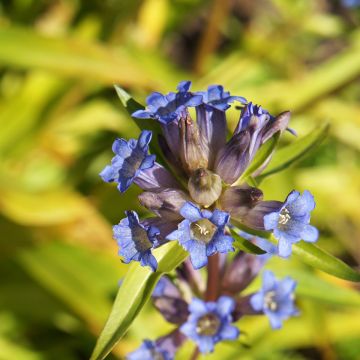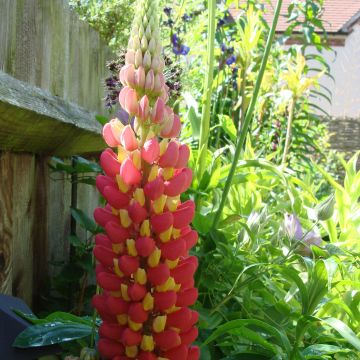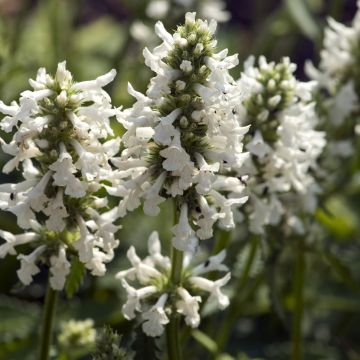

Gentiana cruciata - Cross Gentian


Gentiana cruciata - Cross Gentian


Gentiana cruciata - Cross Gentian


Gentiana cruciata - Cross Gentian
Gentiana cruciata - Cross Gentian
Gentiana cruciata
Cross Gentian
This item cannot be shipped to the selected country
Delivery charge from €5.90
More information
Schedule delivery date,
and select date in basket
This plant carries a 12 months recovery warranty
More information
We guarantee the quality of our plants for a full growing cycle, and will replace at our expense any plant that fails to recover under normal climatic and planting conditions.
From €5.90 for pickup delivery and €6.90 for home delivery
Express home delivery from €8.90.
Does this plant fit my garden?
Set up your Plantfit profile →
Description
Cross Gentian, in Latin Gentiana cruciata, is a perennial plant found in dry meadows, light woods, and rocky slopes in much of Europe. It can be recognised by its large bright green leaves arranged in a cross along the stems. On this bushy tuft, small vivid blue gentian flowers bloom in summer, sometimes nestled in the foliage. This montane perennial is not the easiest to cultivate in the garden: it will thrive in a not too arid situation, in a very well-drained soil, preferably a limestone alpine rockery that is somewhat cool.
The cross gentian, from the Gentianaceae family, is a species native to Europe and Asia. In nature, it can be found at altitudes between 100 and 2100m (328 and 6890ft), but it is absent from Mediterranean regions, which are too hot and dry. A perennial plant with a thick stump and a tufted habit, it consists of leafy stems that disappear in winter and re-emerge from the ground in spring. At maturity, the plant reaches an average size of 27 cm (11in) in all directions, depending on the growing conditions. The reddish-brown, erect-and-curving stems are adorned with numerous lanceolate leaves, 10 cm (4in) long, of a beautiful bright green colour, sheathing at the base. Flowering takes place from June to September. At the end of the leafy stems but also in the axils of the leaves, small trumpet-shaped flowers, 20-25 mm (1in) long, stand upright. Each flower has a corolla composed of 4 well-individualised lobes, of a bright blue colour with an almost black base. The throat of the flower is occupied by white styles, which are the female reproductive organs of the flower.
As is the case with most alpine plants, Cross Gentian will be easy to cultivate as long as the growing conditions suit it. This mountain plant does not appreciate climates that are too hot, or heavy, acidic and/or poorly drained soils. In the ground, it will ideally be placed in a soil rich in limestone pebbles, well-drained, not too dry, on a wall, in a rockery, on a slope, along borders, or in a trough, in a mountain garden. It prefers rocky, sunny spaces that are not too hot or partially shaded, where it can establish deep roots. This gentian can be associated, in a flowerbed or rockery, with e.g. snowdrops, botanical tulips, crocuses, Lewisia, dwarf conifers, pasqueflowers.
This gentian is the exclusive host of the cross gentian blue, a butterfly that has become rare. It lays its eggs on its leaves, and its caterpillars feed on them. At the end of summer, the caterpillars fall to the ground and are collected by certain ants that transport them to their anthill and feed them, like parasites.
The term Gentiana refers to Gentius, king of Illyria (present-day Albania) in the 2nd century BC, who, according to Pliny the Elder, discovered the medicinal and healing properties of the root of yellow gentian.
Report an error about the product description
Gentiana cruciata - Cross Gentian in pictures




Flowering
Foliage
Plant habit
Botanical data
Gentiana
cruciata
Gentianaceae
Cross Gentian
Alps
Other Gentian
Planting and care
Cross Gentian should be planted in spring or autumn. Place in a well-drained soil, enriched with limestone gravel and leaf compost. The soil shouldn't be too dry in summer. This plant, fairly hardy (-15°C (5°F)), does not appreciate very hot climates and scorching summers, nor soils that are compact, heavy, or wet in winter. In spring, fertiliser in the form of hoof and horn or well-rotted manure will be welcome. Its flowers open in the light and close in the evening, so a partially shaded or sunny but not scorching site will be welcome. In a cold greenhouse, this gentian should be planted in a pot measuring 10 to 20 cm (4 to 8in), depending on the size of the plant, and in a mixture of compost and gravel. Repot every year, without disturbing the main root of the plant. Take care to protect it from gastropods in the garden and red spiders in the greenhouse.
Planting period
Intended location
Care
-
, onOrder confirmed
Reply from on Promesse de fleurs
Summer flowering perennials
Haven't found what you were looking for?
Hardiness is the lowest winter temperature a plant can endure without suffering serious damage or even dying. However, hardiness is affected by location (a sheltered area, such as a patio), protection (winter cover) and soil type (hardiness is improved by well-drained soil).

Photo Sharing Terms & Conditions
In order to encourage gardeners to interact and share their experiences, Promesse de fleurs offers various media enabling content to be uploaded onto its Site - in particular via the ‘Photo sharing’ module.
The User agrees to refrain from:
- Posting any content that is illegal, prejudicial, insulting, racist, inciteful to hatred, revisionist, contrary to public decency, that infringes on privacy or on the privacy rights of third parties, in particular the publicity rights of persons and goods, intellectual property rights, or the right to privacy.
- Submitting content on behalf of a third party;
- Impersonate the identity of a third party and/or publish any personal information about a third party;
In general, the User undertakes to refrain from any unethical behaviour.
All Content (in particular text, comments, files, images, photos, videos, creative works, etc.), which may be subject to property or intellectual property rights, image or other private rights, shall remain the property of the User, subject to the limited rights granted by the terms of the licence granted by Promesse de fleurs as stated below. Users are at liberty to publish or not to publish such Content on the Site, notably via the ‘Photo Sharing’ facility, and accept that this Content shall be made public and freely accessible, notably on the Internet.
Users further acknowledge, undertake to have ,and guarantee that they hold all necessary rights and permissions to publish such material on the Site, in particular with regard to the legislation in force pertaining to any privacy, property, intellectual property, image, or contractual rights, or rights of any other nature. By publishing such Content on the Site, Users acknowledge accepting full liability as publishers of the Content within the meaning of the law, and grant Promesse de fleurs, free of charge, an inclusive, worldwide licence for the said Content for the entire duration of its publication, including all reproduction, representation, up/downloading, displaying, performing, transmission, and storage rights.
Users also grant permission for their name to be linked to the Content and accept that this link may not always be made available.
By engaging in posting material, Users consent to their Content becoming automatically accessible on the Internet, in particular on other sites and/or blogs and/or web pages of the Promesse de fleurs site, including in particular social pages and the Promesse de fleurs catalogue.
Users may secure the removal of entrusted content free of charge by issuing a simple request via our contact form.
The flowering period indicated on our website applies to countries and regions located in USDA zone 8 (France, the United Kingdom, Ireland, the Netherlands, etc.)
It will vary according to where you live:
- In zones 9 to 10 (Italy, Spain, Greece, etc.), flowering will occur about 2 to 4 weeks earlier.
- In zones 6 to 7 (Germany, Poland, Slovenia, and lower mountainous regions), flowering will be delayed by 2 to 3 weeks.
- In zone 5 (Central Europe, Scandinavia), blooming will be delayed by 3 to 5 weeks.
In temperate climates, pruning of spring-flowering shrubs (forsythia, spireas, etc.) should be done just after flowering.
Pruning of summer-flowering shrubs (Indian Lilac, Perovskia, etc.) can be done in winter or spring.
In cold regions as well as with frost-sensitive plants, avoid pruning too early when severe frosts may still occur.
The planting period indicated on our website applies to countries and regions located in USDA zone 8 (France, United Kingdom, Ireland, Netherlands).
It will vary according to where you live:
- In Mediterranean zones (Marseille, Madrid, Milan, etc.), autumn and winter are the best planting periods.
- In continental zones (Strasbourg, Munich, Vienna, etc.), delay planting by 2 to 3 weeks in spring and bring it forward by 2 to 4 weeks in autumn.
- In mountainous regions (the Alps, Pyrenees, Carpathians, etc.), it is best to plant in late spring (May-June) or late summer (August-September).
The harvesting period indicated on our website applies to countries and regions in USDA zone 8 (France, England, Ireland, the Netherlands).
In colder areas (Scandinavia, Poland, Austria...) fruit and vegetable harvests are likely to be delayed by 3-4 weeks.
In warmer areas (Italy, Spain, Greece, etc.), harvesting will probably take place earlier, depending on weather conditions.
The sowing periods indicated on our website apply to countries and regions within USDA Zone 8 (France, UK, Ireland, Netherlands).
In colder areas (Scandinavia, Poland, Austria...), delay any outdoor sowing by 3-4 weeks, or sow under glass.
In warmer climes (Italy, Spain, Greece, etc.), bring outdoor sowing forward by a few weeks.























































